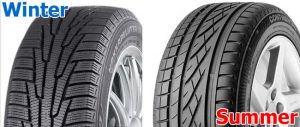June 13, 2016

With the hotter weather approaching, drivers will want to switch their tires to ones better suited for the environment. Summer tires are designed to take the heat and help drivers keep up with difficult conditions on summer roads. However, just like any other tires, car owners need to make sure that they are maintaining their tires correctly to get the most out of them. By following these quick and easy safety tips, anybody can protect their tires during the warmer weather, preventing things such as blowouts and improving the longevity of their cars overall.
Drivers should always keep a tire gauge around, especially if they are planning on taking a longer drive somewhere. Tire gauges are invaluable because they inform individuals when they need to add air to the tires. Any general auto supply store or automotive retailer can provide drivers with one of these items, and they should always be a standard part of any car care kit.
Under inflation and overinflation are both dangerous conditions that can wear down on the tire's longevity and result in potential problems during the drive itself. All drivers should check their tire pressure at least once every month, especially if they are planning on a long trip. Checking on the manufacturer's manual can provide you with additional information on your tire's ideal settings. Always test the tire pressure when the tires are cool, as hotter tires can lead to incorrect readings.
 Spring and summer driving is notorious for wet weather, so be sure to slow down when you are on the road when it rains. As the driver's speed decreases, the tire's footprint, which is the amount of tire tread making contact with a road surface, increases. This provides drivers with better traction, reducing the risk hydroplaning on the road.
Drivers should also take the time to rotate their tires at least every 6,000 miles. If the tires show signs of uneven wear, you may need to speak with a professional to make sure that they are rotated correctly. Imbalances and misalignment are always a possibility, especially if you live in an area that requires for you to make frequent turns on any one side of your car.
Always be sure to inspect and measure the tire tread as well. Place a penny into the tread grooves and check to see if the top of Lincoln's head is visible. If it is, it might be time to replace the tires.
Spring and summer driving is notorious for wet weather, so be sure to slow down when you are on the road when it rains. As the driver's speed decreases, the tire's footprint, which is the amount of tire tread making contact with a road surface, increases. This provides drivers with better traction, reducing the risk hydroplaning on the road.
Drivers should also take the time to rotate their tires at least every 6,000 miles. If the tires show signs of uneven wear, you may need to speak with a professional to make sure that they are rotated correctly. Imbalances and misalignment are always a possibility, especially if you live in an area that requires for you to make frequent turns on any one side of your car.
Always be sure to inspect and measure the tire tread as well. Place a penny into the tread grooves and check to see if the top of Lincoln's head is visible. If it is, it might be time to replace the tires.
Tags: drive safe , driving tips , safe driving , summer driving
Hello {{User.FirstName}} {{User.LastName}}.
You are logged in with email {{User.Email}}.